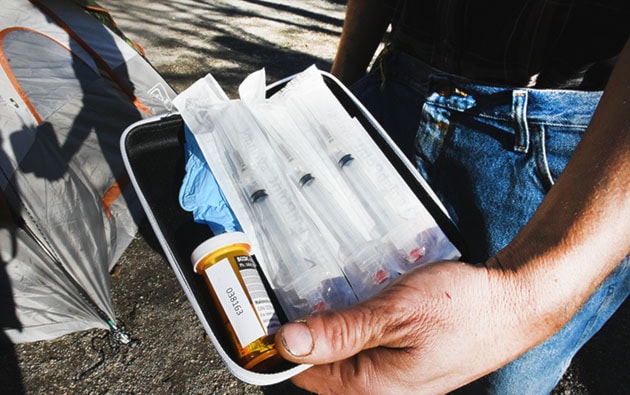“I saved two lives last week,” said a man in his early 30s, as he sidled up to a dozen or so of his peers, huddled under blankets on Leon Avenue.
The comment, which would be remarkable in most circles, prompted little more than nods and utterances of similar anecdotes.
“We saw a guy overdosing on the street last week, and we had to use three (vials from the Naloxone kit) to bring him back,” offered a young woman having her dinner under a Leon awning.
Two, she said, usually does the trick when it comes to opioids, but the drugs on Kelowna’s streets today are cut with so many toxins that all bets are off.
Another said that the Naloxone kits which are used to revive someone who has overdosed are such a hot commodity that she had hers stolen.
“Someone took my whole backpack while I was sleeping, then I found it later with nothing gone but the kit,” she said. “They get used fast.”
These street people —  hungry, tired, mentally ill, high or low — are the real frontline workers in the current effort to save lives from fentanyl drug overdoses, which have risen shockingly in numbers.
hungry, tired, mentally ill, high or low — are the real frontline workers in the current effort to save lives from fentanyl drug overdoses, which have risen shockingly in numbers.
That is why Angie Lohr, with HOPE Outreach, and Ann Keane, started Sunday to go out at night and arm Kelowna’s street population with what they need to save their own lives— Naloxone kits.
Lohr is the face of HOPE Outreach, a volunteer-based organization that helps homeless, exploited and addicted women in Kelowna.
It’s work she’s taken on for personal reasons, which which she tells each person she engages with.
“I don’t know if you’ve heard my story, but I used to be an addict and I’ve been in and out of jail,” Lohr said, as she dropped to one knee Sunday night, speaking eye-to-eye with a woman in her early 20s.
The candid approach prompted the woman to relax and start a conversation with Lohr about the dearth of resources for people wanting to get off the streets and drugs in general.
Both agreed that it’s nearly impossible for a person without means to get clean, given the six to 12 week wait time for a detox bed and then lack of available housing upon getting out.
From there they moved on to a conversation about the Naloxone kits that Lohr was distributing.
“Our volunteers are trained to use a narcan kit if we see anyone overdosing, but the problem has been; does everyone have a kit who is using intravenously?” Lohr said.
“We came across someone who was overdosing three weeks ago and we literally had to scream down the street to see who had a kit.”
In the end, a life was saved. But it became clear that there was a need to get more tools into the hands of the people who use them, and in the weeks since that incident the rules have changed to allow just that.
“Now RNs and social workers can dispense nalaxone kits, not just doctors getting a prescription,” said Lohr.
“But it takes a 10 minute training session. Sometimes the people we come across don’t have time for that during the day.
“HOPE outreach is the only night outreach, so now that the rules have expanded I’m really blessed to have RNs and social workers who are willing to take their own time to teach people.”
In under an hour, Keane and Lohr had handed out 10 kits, and it was made abundantly clear that the service they started providing is needed so they’ll be headed back as needed.
Lohr, whose adopted daughter died from a fentanyl overdose in Surrey earlier this year, said it’s work she’s happy to take on.
“If one person has the kit they can prevent one death down the road and that’s all that matters.”
